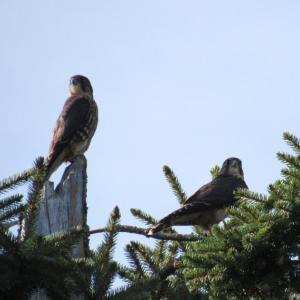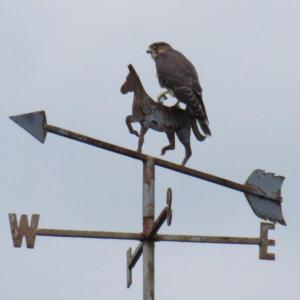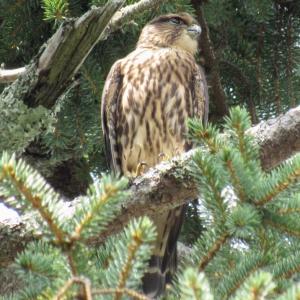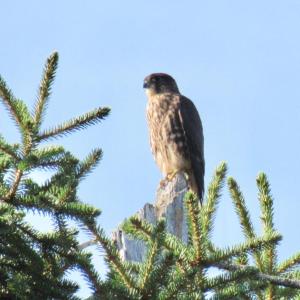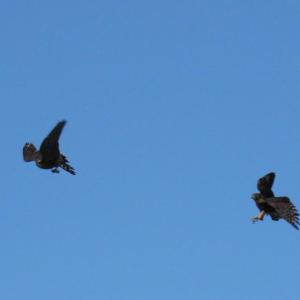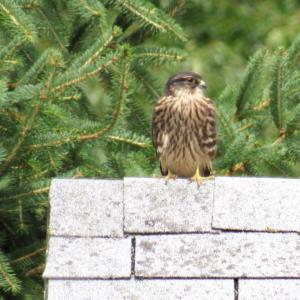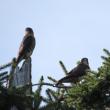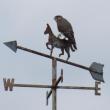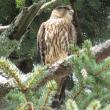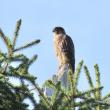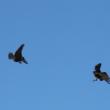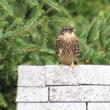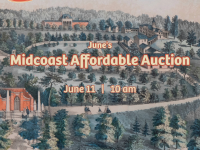Kristen Lindquist: The Merlins of Pearl Street
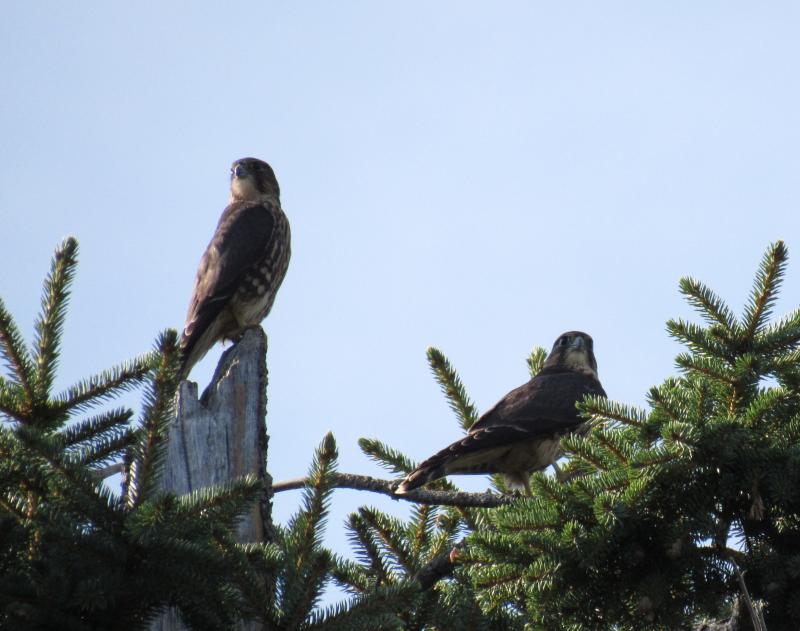 Although from this angle the bird on the left doesn't look noticeably larger than the adult male bird on the right, this is probably the mated pair enjoying moment away from the demanding kids. (Photo courtesy Kristen Lindquist)
Although from this angle the bird on the left doesn't look noticeably larger than the adult male bird on the right, this is probably the mated pair enjoying moment away from the demanding kids. (Photo courtesy Kristen Lindquist)
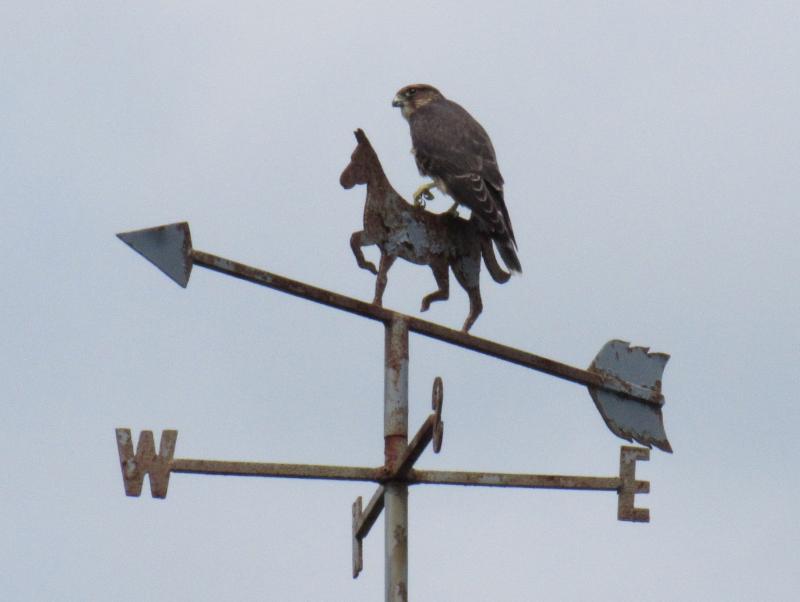 The adult male "daddy" Merlin perches on a weathervane to keep an eye on his neighborhood. (Photo courtesy Kristen Lindquist)
The adult male "daddy" Merlin perches on a weathervane to keep an eye on his neighborhood. (Photo courtesy Kristen Lindquist)
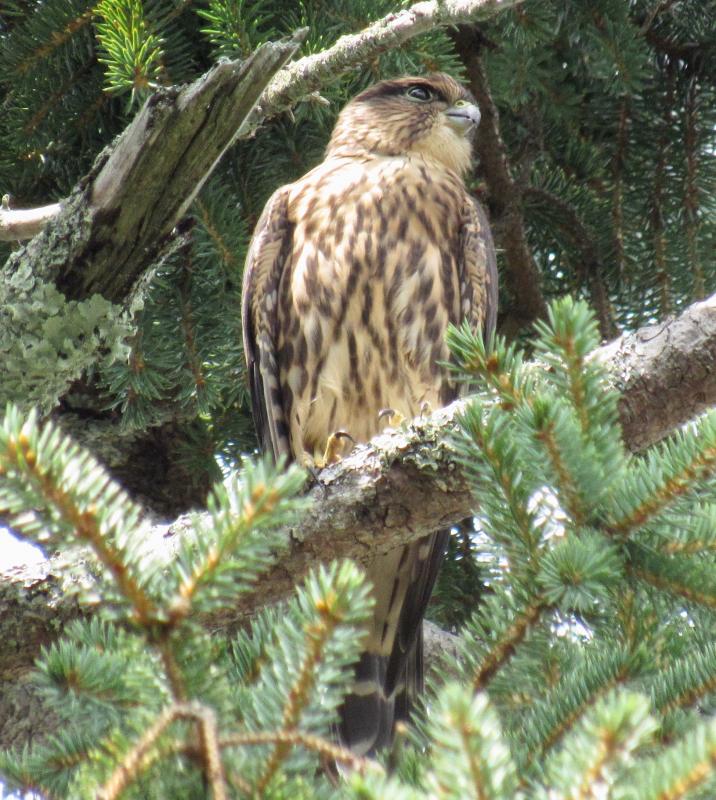 Merlin perched in a spruce tree favored by the family as a local hang-out. (Photo courtesy Kristen Lindquist)
Merlin perched in a spruce tree favored by the family as a local hang-out. (Photo courtesy Kristen Lindquist)
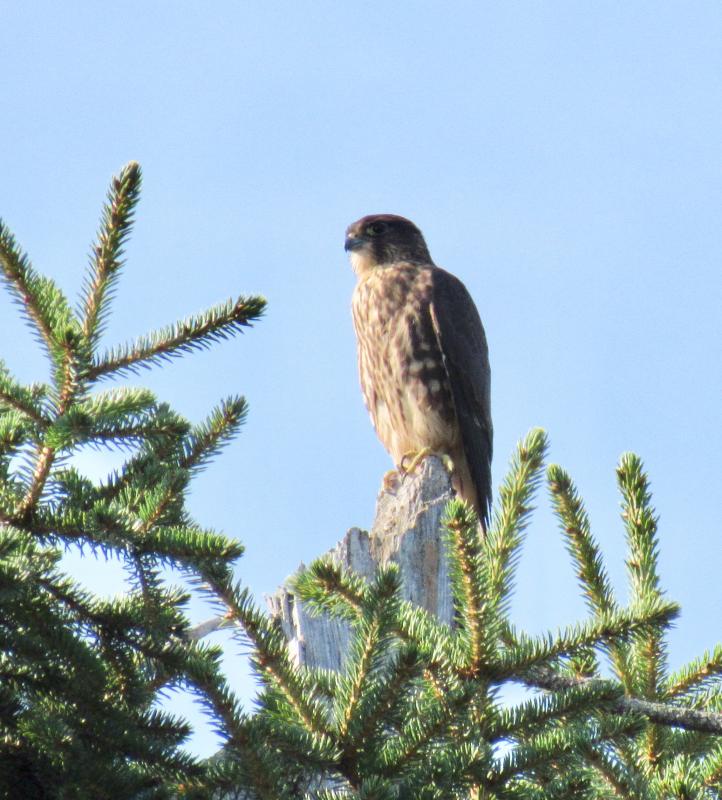 Merlins like to perch in spots with high visibility, to keep a good eye out for potential food or trespassers. (Photo courtesy Kristen Lindquist)
Merlins like to perch in spots with high visibility, to keep a good eye out for potential food or trespassers. (Photo courtesy Kristen Lindquist)
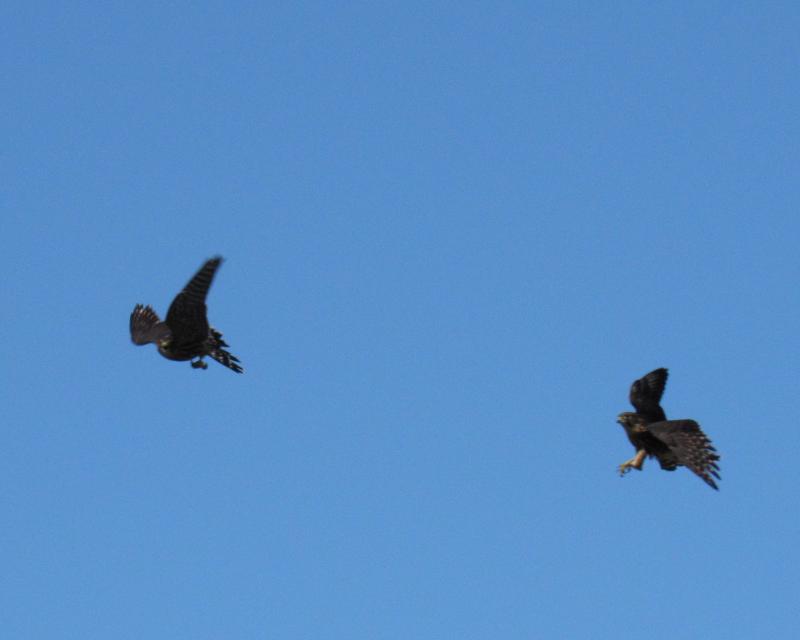 Merlins are strong, skilled fliers, expending a lot of energy chasing prey, perceived intruders, and, apparently, each other. (Photo courtesy Kristen Lindquist)
Merlins are strong, skilled fliers, expending a lot of energy chasing prey, perceived intruders, and, apparently, each other. (Photo courtesy Kristen Lindquist)
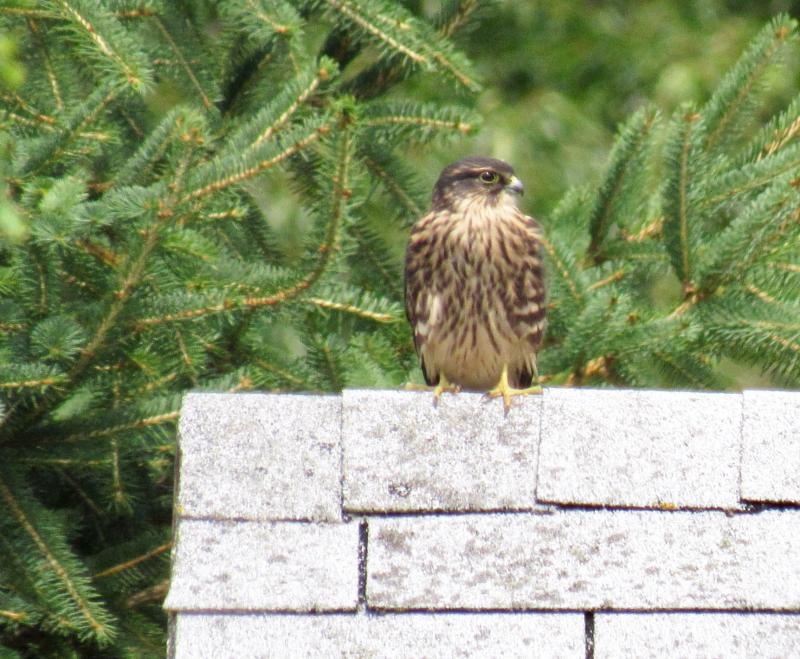 This roof peak is another favorite Merlin perch. This bird may be one of the two fledglings. (Photo courtesy Kristen Lindquist)
This roof peak is another favorite Merlin perch. This bird may be one of the two fledglings. (Photo courtesy Kristen Lindquist)
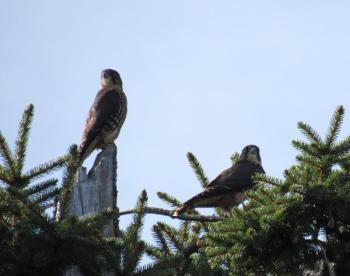 Although from this angle the bird on the left doesn't look noticeably larger than the adult male bird on the right, this is probably the mated pair enjoying moment away from the demanding kids. (Photo courtesy Kristen Lindquist)
Although from this angle the bird on the left doesn't look noticeably larger than the adult male bird on the right, this is probably the mated pair enjoying moment away from the demanding kids. (Photo courtesy Kristen Lindquist)
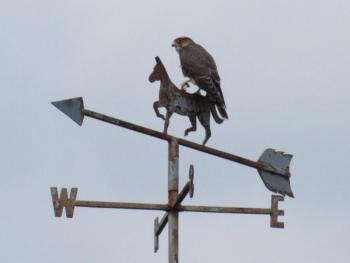 The adult male "daddy" Merlin perches on a weathervane to keep an eye on his neighborhood. (Photo courtesy Kristen Lindquist)
The adult male "daddy" Merlin perches on a weathervane to keep an eye on his neighborhood. (Photo courtesy Kristen Lindquist)
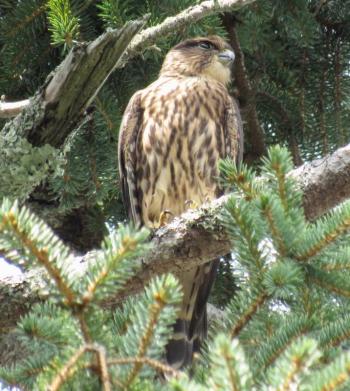 Merlin perched in a spruce tree favored by the family as a local hang-out. (Photo courtesy Kristen Lindquist)
Merlin perched in a spruce tree favored by the family as a local hang-out. (Photo courtesy Kristen Lindquist)
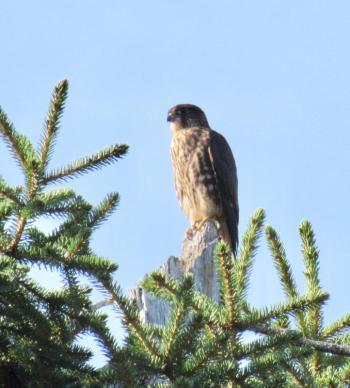 Merlins like to perch in spots with high visibility, to keep a good eye out for potential food or trespassers. (Photo courtesy Kristen Lindquist)
Merlins like to perch in spots with high visibility, to keep a good eye out for potential food or trespassers. (Photo courtesy Kristen Lindquist)
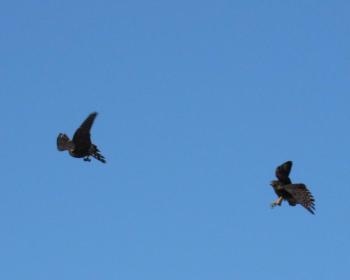 Merlins are strong, skilled fliers, expending a lot of energy chasing prey, perceived intruders, and, apparently, each other. (Photo courtesy Kristen Lindquist)
Merlins are strong, skilled fliers, expending a lot of energy chasing prey, perceived intruders, and, apparently, each other. (Photo courtesy Kristen Lindquist)
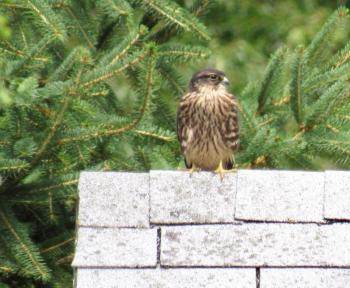 This roof peak is another favorite Merlin perch. This bird may be one of the two fledglings. (Photo courtesy Kristen Lindquist)
This roof peak is another favorite Merlin perch. This bird may be one of the two fledglings. (Photo courtesy Kristen Lindquist)
Some new Camden residents moved into the lower Pearl Street neighborhood this spring, and have distinguished themselves by how noisy they are. But the neighbors aren't complaining. Rather, they're spending more time looking eagerly to the sky as a very vocal and energetic Merlin family of four flies back and forth overhead.
I first heard about these birds in late spring, when two sets of friends in that neighborhood told me about spotting what they thought were falcons living there. "They make a lot of noise," one of them said, which immediately made me think Merlin. Cliff-dwelling Peregrines wouldn't nest in downtown Camden. And having recently observed a Merlin nest in a Portland neighborhood, I also knew that these uncommon predators have been found nesting more frequently in towns and cities. They take over old crow nests and find good eating among the urban flocks of House Sparrows and Starlings.
As often happens in a Maine summer, many weeks went by and I still hadn't seen the birds. Then a Pearl Street resident whom I didn't know emailed me out of the blue: was this a photo of a Merlin? She told me I could come by anytime; the birds lived next-door. So there was validation of my original guess, as well as the extra incentive I needed to get my lazy birding butt over to Pearl Street.
As if that weren't enough, that same night Alison McKellar posted a series of photos of the Merlins on Facebook. The long thread of excited comments quickly made it clear that locals were seeing the birds regularly and had embraced them. Commented Jenna Lookner: "My neighbors! They are quite active and also quite vocal. It's delightful having them right outside my window!" She added, "They are really entertaining and amazing to watch! We've certainly spent cumulative hours doing so. I have had so many conversations on the sidewalk about them, and met so many people, too."
So in late July I parked my car near the Pearl-Norwood intersection, hoping to spot these crowd-pleasers. Barely had I crossed the street when a small falcon shot out of a large pine tree, calling loudly. Yup, that was a Merlin! While I stood there, three others followed. Soon they were all darting back and forth overhead amid a cacophony of strident calls. It seemed as if two of the birds were chasing one of the others, probably two fledglings demanding that one of the parents feed them. I was currently witnessing this same behavior, accompanied by similar whining, among our backyard jay and crow families.
I met the woman who'd emailed me the photo, and we watched together from her driveway as the falcons dashed overhead. "One of them likes to perch there," she said, pointing out a section of guano-patched roof in front of us. Just then, a Merlin swooped in and perched in that very spot, facing us. She noted its yellow feet. About thirty yards behind us, two children were loudly splashing on a slip-and-slide in her backyard. People in conversation went past on the sidewalk; cars zipped by. Clearly the birds were unfazed by any human activity on the street and in the yards. As I was leaving, one of the birds landed on a power line directly over my head, clutching a butterfly. As I paused, it calmly began plucking at the fluttering insect. Of course I didn't have my camera.
The next few times I went by, camera in hand, several people in the neighborhood stopped to talk to me. As Jenna had said, the charismatic birds have built community. One shared with me his own photos of the Merlins. A guy siding a house spoke with affection of the birds. Others commented on how much they enjoyed seeing the birds every day, even if their presence meant having to take down bird feeders and get used to seeing the plucked feathers of goldfinches and chickadees drifting overhead.
The Peregrine Falcon is our fastest animal, clocked at over 200 MPH when diving on prey. As an aerial predator, its cousin the Merlin also relies on speed, chasing quarry on strong wings at well over 40 MPH, executing its final attack from behind or below. They'll hunt down anything in flight smaller than themselves: from dragonflies and butterflies to songbirds and shorebirds, especially those in flocks.
While the Merlin was once called the Pigeon Hawk, it wasn't because it typically eats them—the larger Peregrine is the pigeon specialist—but because of its similar silhouette in flight. Hence, the Merlin's Latin name: Falco columbarius, roughly meaning "dove-like falcon." In temperament, however, it's not Dove-like at all; the feisty merlin is all Hawk. While seemingly tolerant of human passers-by, this bold little bird doesn't suffer other birds gladly. Ornithologist and writer Pete Dunne calls the Merlin the "Falcon with Attitude" and adds, "Very few creatures covered with feathers and smaller than a pigeon want to be near a Merlin."
Its pugnacious attitude means it'll go after any bird. Like belligerent street brawlers, two Merlins (outside of a family unit) can barely share airspace without a dogfight. I've often watched migrating Merlins aggressively make passes at much larger raptors, including Peregrines and eagles. On Pearl Street, they regularly escort gulls out of their airspace. The Ospreys nesting on the downtown smokestack, within their line of sight, must drive them crazy.
A careful observer might be able to pick out the "daddy bird" from among the four Pearl Street Merlins. He's the one wearing the grey-blue suit above, with brown streaks down his front. The female is brown above, as are the youngsters. As with many hawk species, she is also notably larger than her mate. Both genders sport the characteristic falcon mustache.
It's not often birds of prey come to live among us, right in our own back yards. Many songbirds quietly raise their families around us and we barely notice. But you can't miss a family of Merlins. Thankfully the residents of Pearl Street have welcomed these raucous immigrants, even though they keep early hours and follow an unorthodox diet. When the Merlins, along with many other Camden residents, head south soon for the winter, the neighborhood might seem a bit too quiet. But hopefully the falcon pair are finding this community a great place to bring up their kids. Hopefully they have been appreciating the abundance of locally grown food and the friendly neighbors, and will return.
PLEASE NOTE: If you are in the neighborhood and want to see the birds, please stay on the sidewalk. Residents would prefer that you not walk on their lawns or in their driveways without permission.
Kristen Lindquist is an amateur naturalist and published poet who lives in her hometown of Camden.
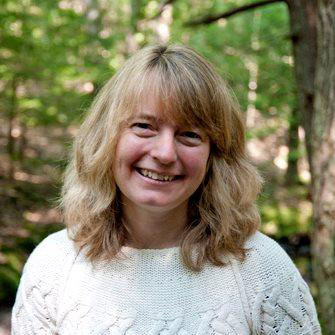
A summer walk through Monhegan's Cathedral Woods
Growing your natural literacy, one Maine state symbol at a time
Snow Buntings—Bringing winter to life
Winter life inside a beaver lodge
Migrating flickers and falcons
Orchids —They're not just in the tropics
• Meditations on an unlikely harbinger of spring
• Meditations on the Snow Goose
• Sky-watching during the holiday season
• Understanding the Aurora Borealis
• Get to know the constellation Gemini
• Celebrate September’s full moon
• Northern Sky basics with the Big Dipper
• Early Christmas morning: Look up! A full moon, and Orion bright in the sky
Event Date
Address
United States

